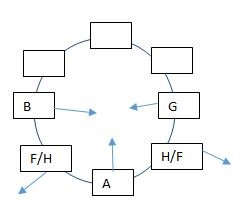Question
Who sits second the left of A? I. Eight
friends are sitting around a circular table four facing towards the center and four facing away from the center such that no two people facing in the same direction are sitting adjacent to each other. A sits second to the left of G who sits fourth to the right of B. F and H are the immediate neighbours of A and face outside. II. Eight friends are sitting around a circular table such that friends sitting alternately are facing in the same direction (away from the center or towards the center). A, B, G and E face towards the center and C, D, F, H face away from the center. Each of the questions given below has one question and two statements marked I and II. You have to decide whether the data provided in the statements are sufficient to answer the question. Read both the statements and give answer.Solution
From 1, we know that, people sitting adjacent to each other face in opposite directions. Thus, if neighbours of A face outside, A faces inside. Also, A sits second to the left of G thus G also faces inside and by placing B such that G sits fourth to the right of B, we get the following arrangement.  From II, we know that A, B, G and E face towards the center and C, D, F, H face away from the center, but do not know their placements and position.
From II, we know that A, B, G and E face towards the center and C, D, F, H face away from the center, but do not know their placements and position.
What is the term length of a member of the Lok Sabha.
How many types of emergencies are recognized under the Indian Constitution?
In the context of seismic activity of earth, what are swarms?
Which of the following Fundamental Rights under Part III of the Indian Constitution are available only to Indian citizens?
1. Right to elementary...
The Sabarimala Verdict (2018) ruled on which issue?
Which mountain range in India is also known as the "Blue Mountains"?
Consider the following statements:
1. Only Parliament shall have the power to make laws restricting the application of Fundamental Rights to memb...
Consider the following statements about the Central Bureau of Investigation (CBI):
1. It deals only with cases of corruption and economic offense...
Consider the following statements with respect to Fundamental Duties:
1. The Fundamental Duties were inspired by the Constitution of the USA.
...Which article can not be suspended even during the Emergency ?


